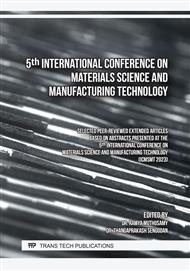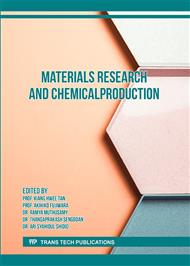[1]
Ramesh Kumar, Chellamuthu, Baskar, Subramanian, Ramesh, Ganesan, Gurusamy, Pathinettampadian, and Maridurai, Thirupathy, "Process optimization using grey relational analysis in dry sliding wear behavior on SiC/B4C/Talc reinforced Al 6061 hybrid metal matrix composite," Met. Res. Technol., vol. 118, no. 6, p.614, 2021.
DOI: 10.1051/metal/2021086
Google Scholar
[2]
Y. Sesharao et al., "Optimization on operation parameters in reinforced metal matrix of AA6066 composite with HSS and Cu," Adv. Mater. Sci. Eng., vol. 2021, 2021.
DOI: 10.1155/2021/1609769
Google Scholar
[3]
K. Saravanan, J. Francis Xavier, M. P. Sudeshkumar, T. Maridurai, V. Suyamburajan, and V. Jayaseelan, "Optimization of SiC Abrasive Parameters on Machining of Ti-6Al-4V Alloy in AJM Using Taguchi-Grey Relational Method," Silicon, vol. 14, no. 3, p.997–1004, 2022.
DOI: 10.1007/s12633-020-00918-z
Google Scholar
[4]
R. Suhail Ahmed Adnan, "The effect of tin addition on wear resistance of Cu-Al-Ni shape memory alloy," Mater. Today Proc., vol. 62, p.3544–3547, 2022.
DOI: 10.1016/j.matpr.2022.04.395
Google Scholar
[5]
G. Wang, S. Wang, Z. Yin, X. Yang, D. Wen, and Y. Sun, "Synthesis of Ni-WC/Al-Ni functionally graded coating with advanced corrosion and wear resistance on AZ91D Mg alloy by laser cladding," Mater. Lett., vol. 333, no. September 2022, p.133645, 2023.
DOI: 10.1016/j.matlet.2022.133645
Google Scholar
[6]
D. Wang et al., "Study on the microstructure and wear behavior of Mg-containing Al–12Sn–4Si alloys," J. Mater. Res. Technol., vol. 18, p.338–351, 2022.
DOI: 10.1016/j.jmrt.2022.02.087
Google Scholar
[7]
A. G. Lekatou, A. K. Sfikas, D. Sioulas, and A. Kanderakis, "Sliding wear performance of Al–Co alloys fabricated by vacuum arc melting and correlation with their microstructure," Mater. Chem. Phys., vol. 276, no. September 2021, p.125411, 2022.
DOI: 10.1016/j.matchemphys.2021.125411
Google Scholar
[8]
X. Wu et al., "Dry sliding wear of microalloyed Er-containing Al–10Sn–4Si–1Cu alloy," J. Mater. Res. Technol., vol. 9, no. 6, p.14828–14840, 2020.
DOI: 10.1016/j.jmrt.2020.10.085
Google Scholar
[9]
J. S. Rodríguez, J. F. Duran, Y. Aguilar, G. . P. Alcazar, A. Toro, and O. A. Zambrano, "Effect of Al content on the low-stress abrasive wear behaviour of Fe-18Mn-xAl-0.7 C alloys," Tribol. Int., vol. 180, no. September 2022, p.108286, 2023.
DOI: 10.1016/j.triboint.2023.108286
Google Scholar
[10]
R. Chen, H. Wang, J. Li, B. He, W. Shao, and S. Zhang, "Effect of laser remelting and heat treatment on microstructure and wear resistance of 2A97 Al-Li alloy," Surfaces and Interfaces, vol. 33, no. July, p.102197, 2022.
DOI: 10.1016/j.surfin.2022.102197
Google Scholar
[11]
H. M. Pruthvi and H. Ghanashyam Shenoy, "Effect of wear parameter on Al-Zn alloy on wear rate by using Taguchi's technique," Mater. Today Proc., vol. 59, p.79–84, 2022.
DOI: 10.1016/j.matpr.2021.10.204
Google Scholar
[12]
Y. Liu, L. Jia, W. Wang, Z. Jin, and H. Zhang, "Effects of Ni content on microstructure and wear behavior of Al–13Si–3Cu–1Mg-xNi-0.6Fe-0.6Mn alloys," Wear, vol. 500–501, no. April, p.204365, 2022.
DOI: 10.1016/j.wear.2022.204365
Google Scholar
[13]
P. Mittal, H. Rai, S. Kumari, O. P. Khatri, and N. N. Gosvami, "Efficient friction and wear reduction of Al-Si alloy via tribofilms generated from synergistic interaction of ZDDP and chemically functionalized h-BN additives," Appl. Surf. Sci., vol. 595, no. April, p.153520, 2022.
DOI: 10.1016/j.apsusc.2022.153520
Google Scholar
[14]
M. Mohedano, E. Lopez, B. Mingo, S. Moon, E. Matykina, and R. Arrabal, "Energy consumption, wear and corrosion of PEO coatings on preanodized Al alloy: The influence of current and frequency," J. Mater. Res. Technol., vol. 21, p.2061–2075, 2022.
DOI: 10.1016/j.jmrt.2022.10.049
Google Scholar
[15]
X. Ma et al., "Influence alloying elements of Al and Y in Mg–Li alloy on the corrosion behavior and wear resistance of microarc oxidation coatings," Surf. Coatings Technol., vol. 432, no. October 2021, p.128042, 2022.
DOI: 10.1016/j.surfcoat.2021.128042
Google Scholar
[16]
T. Song et al., "Improvement of corrosion and wear resistance of novel Zr-Ti-Al-V alloy with high strength and toughness by thermal nitridation treatment," Corros. Sci., vol. 208, no. September, p.110685, 2022.
DOI: 10.1016/j.corsci.2022.110685
Google Scholar
[17]
D. S. Ahammed, A. Abdullah, A. Asif, and M. Salim, "Materials Today : Proceedings Impact of under , peak and over-ageing on the wear properties of Si- doped Al-based automotive alloy," Mater. Today Proc., no. xxxx, 2023.
DOI: 10.1016/j.matpr.2023.02.006
Google Scholar
[18]
T. A. Yilmaz, Y. Totik, G. M. Lule Senoz, and B. Bostan, "Microstructure evolution and wear properties of ECAP-treated Al-Zn-Mg alloy: Effect of route, temperature and number of passes," Mater. Today Commun., vol. 33, no. September, p.104628, 2022.
DOI: 10.1016/j.mtcomm.2022.104628
Google Scholar
[19]
Y. kuan Zhou et al., "Microstructure and sliding wear behavior of HVOF sprayed Al(1−x)CoCrFeNiTix high-entropy alloy coatings," Mater. Lett., vol. 314, no. January, p.131929, 2022.
DOI: 10.1016/j.matlet.2022.131929
Google Scholar
[20]
H. suo et al., "Interfacial wear damage mechanism between Ti-alloy and Al-alloy in interference-fit joint and influence of surface coatings: Experimental and numerical study," Eng. Fail. Anal., vol. 143, no. PB, p.106931, 2023.
DOI: 10.1016/j.engfailanal.2022.106931
Google Scholar



